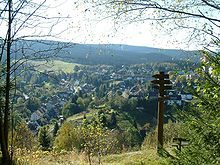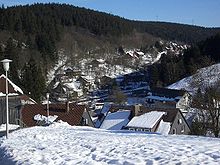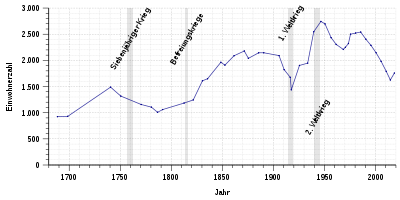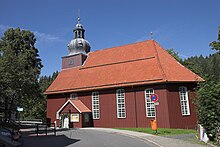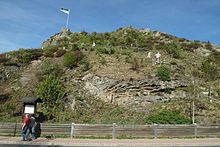Altenau
|
Altenau
Mountain and university
town Clausthal-Zellerfeld |
||
|---|---|---|
| Coordinates: 51 ° 48 ′ 13 ″ N , 10 ° 26 ′ 50 ″ E | ||
| Height : | 513 m above sea level NHN | |
| Area : | 4.66 km² | |
| Residents : | 1758 (Jan. 2018) | |
| Population density : | 377 inhabitants / km² | |
| Incorporation : | January 1, 2015 | |
| Postcodes : | 38707, 38667 (peat house) | |
| Primaries : | 05320, 05328 | |
|
Location of Altenau in Lower Saxony |
||
|
View of Altenau from the Schwarzenberg
|
||
The formerly free mountain town of Altenau ( ) is part of the village of Bergstadt Altenau-Schulenberg in the Upper Harz Mountains in the mountain and university town of Clausthal-Zellerfeld in the Goslar district in Lower Saxony . Altenau is a state-approved climatic health resort in the Upper Harz . Altenau received city rights in 1617 . From 1972 to 2014 the mining town of Altenau was part of the Upper Harz municipality .
geography
Geographical location
The place is centrally located in the Upper Harz. Clausthal-Zellerfeld in the west is about ten kilometers, Goslar in the north about 15 km and Osterode am Harz in the southwest about 25 km away. To the east of the mountain town, twelve kilometers away, is the summit of the Brocken , which can be seen from many places in Altenau. The Oker flows through Altenau from south to north . Other streams flow into the Oker in the urban area and give Altenau a townscape with numerous valleys and hilltops. The area is heavily forested.
Local division
The Torfhaus settlement about ten kilometers away belongs to Altenau . This is at the highest point of the B 4 at about 800 m above sea level and consists mainly of tourist businesses. Torfhaus is located in the Harz National Park . In addition, the Dammhaus , the Polstertaler Zechenhaus , the Bastesiedlung and Gemkenthal are in the local area.
climate
Due to its altitude, Altenau is a rather cool place by Lower Saxony standards. The annual mean temperature is +6.2 ° C. The average annual sunshine duration is 3.7 hours. The average annual rainfall is 1252 mm, of which a not insignificant part falls as snow for Lower Saxony conditions.
history

- 1227 First mentioned in connection with mining
- 1412 Construction of a house "Altenah" by the Duke of Braunschweig
- 1525 citizens of Altenau join forces to form a shooting society.
- 1532 mention of a mine in Altenau
- 1540 Start of mining at the Gang treasury and other pits
- 1570 Start of mining at other pits
- 1580 First mentioned as Bergflecken, 20 houses, today Rotenberger Straße and Oberstraße crossing the treasury
- 1584 Ironworks to the favor
- 1588 Documentary mention of a church
- 1594 mention of 35 houses. Duke Wolfgang gave the place the directionality
- 1603 Already 50 buildings are mentioned
- 1606 Construction of the first town hall
- 1610 Previous construction of a silver smelter
- 1617 Elevation of Altenau to town
- 1636 Altenau fell to Duke August zu Braunschweig-Lüneburg-Celle
- 1636 Altenau became a free mining town
- 1642 Construction of the steeple of the later St. Nikolai Church
- 1653 50 houses are counted
- 1665 Altenau finally came to Hanover after disputes over inheritance
- 1669 Construction of the St. Nikolai Church in place of the previous building, located between the two settlement centers of the city
- 1673 Construction of today's town hall
- 1691 New construction of the silver smelter
- 1698 930 inhabitants are counted
- 1711 Start of mining at the Silberlilie mine
- December 18, 1729 flood of the Oker
- 1740 1400 inhabitants are counted
- 1746 closure of the pits on the Gerlachsbach
- 1748 Closure of the Güldener Hirsch mine
- 1762 Closure of the Green Treasury and Rose
- 1773 The silver lily pit is closed
- 1777 Johann Wolfgang von Goethe stays in Altenau
- July 6, 1794 a large fire destroyed 29 houses in the Breite Strasse
- 1794 Construction of a fiscal ironworks below the silverworks
- 1813 1174 inhabitants and 165 houses are counted
- 1871 cessation of the ironworks
- 1901 Foundation of the volunteer fire brigade
- 1911 closure of the silver smelter
- 1914 Connection of Altenau to the Innerstetalbahn
- 1972 Administrative community within the joint municipality of Upper Harz
- 1972 Construction of the holiday park "Glockenberg"
- 1977 Closure of the Innerstetalbahn
- 2015 The mining town of Altenau is dissolved
Altenau was first mentioned in 1227 in connection with mining. In 1298 there was a smelting company in the Tischlertal, which was handed over to the Goslarer Burchard Erhaftig by Burchard von Wildenstein. This hut stands in 1310 and is run by Albrecht Colven. In 1411, the Duke of Braunschweig built a blockhouse in Altenah, which is to serve as a retreat for sieges of the Harzburg. In 1525, the citizens of Altenau came together to form a shooting society. Developed in the late Middle Ages , the place gained importance during the Upper Harz mining (especially silver mining). The first settlements were in Rotenberger Straße (No. 10-12) near the former silver smelter and the upper part of Oberstraße, where mining was carried out from 1540 onwards. A first church was built between the two settlements in 1588 on a terrace above the Okerschleife. In 1594 Altenau, which at that time had 35 houses, was granted directivity by the duke. Previously, the place was subordinate to the chief forester Barthold Gümpell and Zacharias Hennings zu Osterode. In 1603 Altenau already had 50 houses. The first town hall was built in 1606. In 1617 Altenau was made a town. During the Thirty Years' War , Altenau received letters of protection from Tilly in 1626, among other things. In 1636 the place received the title of a free mountain town. In the course of the city expansion in the 17th century, the valley was built on. The first settlers had avoided building there due to the risk of flooding from the Oker flowing there. Before the development, the valley was covered with rubble. The place owes its name to the brook "Alte Aue" or "Altenah", which absorbs the water from the Lilierkopf and continues through the Tischlertal. A little below the parking lot in the Tischlertal on the state road L 504, the Altenau absorbs the water from the cutting water and flows through the Schultal until it joins the Oker at the market square.
In the middle of the 17th century, the houses at the Brauhaus, at the Mühlenberg (where a mill was named after it) and a closed row of houses in front of the Schwarzenberg, between Schneidwasser and Oker, stood. The Silberhütte was first built below Altenau in 1606–1618. A new building took place in 1691. Mining flourished, and Altenau was soon operating twenty main plants. In Altenau you can find many witnesses of the former mining in old pits and shafts, monuments, the Erzgebirge origins of the Harzers and their Erzgebirge dialect . With the closure of pits in a period from 1750 to 1780, there was an emigration from Altenau, so that the population decreased from 1488 in 1740 to 1007 in 1780. In 1794 an ironworks was built below the silverworks. In 1813 Altenau had 1,174 inhabitants and 165 houses. The ironworks closed in 1871 and the silverworks closed in 1911 due to unprofitability. From 1914 to 1977 Altenau was the terminus of the Innerstetalbahn.
In 1972 Altenau became part of the Upper Harz municipality. In the same year, the Glockenberg holiday park was built and other residential buildings were built alongside the high-rise buildings.
Today Altenau is known for tourism, due to its idyllic location in the middle of the Harz Mountains and its offers of leisure activities, such as numerous hiking trails and cross-country trails , many lakes that invite you to swim in summer. Tourism began with the continuation of the Goslar-Clausthal / Zellerfeld railway to Altenau in 1913. From 1914 to 1970, the number of spa guests and overnight stays rose steadily; 30% of this was attributable to health resorts and 70% to private renters. Since the beginning of the 1990s, the West Harz region has been suffering from the decline in tourist numbers, which has various causes. The municipality of Upper Harz incurred very high costs every year through the operation of the Aqua-Polaris building complex , consisting of a wave swimming pool and ice rink, which was built in the 1970s and adapted to the high tourist numbers of the 1970s and 1980s. In March 2007, he gave way to the new construction of the thermal baths and saunas, Kristall Hot Brocken .
On January 1, 2015, the Upper Harz municipality and its affiliated municipalities, Bergstadt Altenau, Bergstadt Clausthal-Zellerfeld, Bergstadt Wildemann and Schulenberg im Oberharz, were dissolved by state law and the new mining and university town of Clausthal-Zellerfeld was formed from the previously independent municipalities. Previously, 62% of the Altenauers who voted had spoken out against it in a public survey; however, according to a clause in the statutes, the result was not binding on the council. Since then, the previous mountain town of Altenau and the previous community of Schulenberg in the Upper Harz have formed the joint village of Altenau-Schulenberg in the Upper Harz with a local council.
Events
The mining town of Altenau was protected by several letters of protection during the Thirty Years War.
Due to Altenau's location on the Oker, there has always been a flood potential. The first flood occurred on December 18, 1729, and another occurred in 1740. Also in 1740 the stuffing mill and a coal shed in the silver smelter burned down. Three buildings in Bergstrasse fell victim to a fire on November 3, 1758 and three houses on Schützenklippe in 1771. On July 6, 1794, a fire destroyed 29 buildings at Breite Strasse.
In 1953 Altenau was hit by a flood that damaged the Okerteich forest swimming pool and other buildings.
In 1970 an avalanche broke loose and buried two people under it.
When the snow melted on February 22, 2010, the city center of Altenau was flooded and buildings were damaged by the ice flowing through the Oker.
Place name
Former place names of Altenau were in the years 1298 Altena, 1311 Altena, in the 16th century altena, 1542 Altenau, 1587 Altenaw, 1677 Altenau and 1679 Altenauer Weg. The name Altenaus occurs in 1298, the Civil Burch Hard one as the Knights Burchard of Wildenstein Ehrhaftig to Goslar CASAM que dicitur Altena to feudal handed. The origin of Altena refers in the stem a , Old High German aha , acha , ach to the word water. Already in Gothic it is ahva and is of the same origin as the Latin aqua . The first part of the name Altenau refers to the Gothic alan , which means to grow up and is in turn related to the Latin alere (to raise). Taken together, the two parts of the word Altenau therefore denote a river that is reinforced by tributaries. Considerable amounts of water are supplied to the Altena brook coming from the Wolfswarte through the Kleine Altena, the Lilierwasser and other tributaries.
Population development
|
|
|
¹ according to the version history of the city
² on December 31st
religion
The Protestant majority of the population is organized in the parish of St. Nikolai, the center of which is the St. Nikolai Church, built in 1669 in the center of Altenau. The parish today belongs to the Clausthal-Zellerfeld parish, which also includes the St. Petrus Chapel in Schulenberg .
The Catholic St. Oliver Church from 1979 is located on the Glockenberg. Today the church belongs to the parish of St. Nikolaus in Clausthal-Zellerfeld .
politics
Local council (before 2015 city council)
Since the incorporation, the district of Altenau, together with Schulenberg in the Upper Harz Mountains, forms the town of Bergstadt Altenau-Schulenberg in the Upper Harz Mountains with a joint local council . This was first elected on April 26, 2015.
| Local election | SPD | CDU | Single applicant Trenke | FDP | total |
|---|---|---|---|---|---|
| 11th September 2016 | 8 (72.67%) |
2 (21.76%) |
1 (3.89%) |
- (1.66%) |
11 seats |
| September 11, 2011 | 6 (54.77%) |
5 (45.23%) |
- | - | 11 seats |
| September 10, 2006 | 7 (54.16%) |
6 (45.84%) |
- | - | 13 seats |
Local mayor
The local mayor is Alexander Ehrenberg (SPD).
Former mayors:
- 1856 Tolle (first mayor)
- 1878 Rössing
- 1879 Jordan
- 1890 Hodann
- 1894 Aderhold
- 1896 king
- 1904 Schmidt
- 1908 (February 17th) Dr. Angel
- 1913 angel
- 1915 custom
- 1918 Unoccupied
- 1919 Cooper
- 1931 Breyel
- 1946-1948 Tosch
- 1948-1953 Heins
- 1950 Heins (Mayor), Breyel (City Manager)
- 1953–1956 squire
- 1956–1971 forester
- 1971–1976 Biegholdt
- 1976-1981 Loikkasek
- 1981–1986 Biegholdt
- 1986–1991 Schierloh
- 1991-2005 Gerhard Lindemann
- since 2005 Alexander Ehrenberg
coat of arms
| Blazon : “In the shield split by green and silver , three brown bear paws (arranged 1: 2); the one in front holds a black iron , the one in the rear a similar mallet ; the upper paw clasps a black wolf tang . " | |
| Reasons for the coat of arms: Although bears no longer populate the Harz Mountains, three bear paws can still be found in the coat of arms of the mountain town of Altenau. In heraldic ways, however, they come from a completely different place, namely from County Hoya . When the Counts of Hoya died out in 1582, the Guelphs inherited them and added the bear limbs to their multi-field national coat of arms. When the Guelph Dukes bestowed coats of arms on their cities, they sometimes gave their loyal subjects individual items from their own coat of arms, for example the Altenauers, to whom Duke Christian von Braunschweig-Lüneburg-Celle presented a coat of arms split in green and silver on October 30, 1617, the three brown ones Contained bear paws - perhaps because of the obvious reference here to the former occurrence of "Meister Petz" in the Harz Mountains. Mallets and irons together were the tools of the silver and ore mining that was once important here. As a forest symbol, the wolf angel symbolizes the abundance of forests and the timber industry. |
Culture and sights
Altenau is today a climatic health resort. The city is characterized by old miners' houses from the time when Altenau was a free mining town. The use of wood as a building material is typical of the region. In the village is the relatively small wooden church of St. Nikolai , which was built in 1669. The architectural style of the houses is well adapted to the harsh winters and has an architectural style typical of the Harz region. To the south of the town center is the Schützenklippe, from which there is a panoramic view of the town.
In 2004 the largest herb park in Germany was opened in Altenau . Many thousands of tourists visit the year-round cultivated botanical garden, which shows a multitude of varieties . Other sights can be reached on foot via hiking trails. One comes across the Harz Witches to Dammgraben with the Dammhaus and the Polsterberg Pumphouse . Furthermore, hiking trails lead to the Kellwassertal at the Vorsperre to the Okertalsperre and to Torfhaus in the Harz National Park. The Heimatstube in Altenau offers an insight into the history of the Upper Harz. The exhibition there is dedicated to the presentation of the living conditions in the Upper Harz, which were strongly influenced by mining and the professions that depend on it - metallurgy, forestry, charcoal-burning and haulage. An important focus of the collection is the life's work of the artist Karl Reinecke-Altenau .
Regular events
- Walpurgis Night (every April 30th)
- Hubertus Week (mid-September)
- Torchlight walks
- Altenauer Heimatfest (every five years)
- Oktoberfest of the fire brigade
- Overall Harz yodelling competition (took place in Clausthal-Zellerfeld until 2019)
- The place is one of the eight places in which the tradition of the finch maneuver in the Harz , which has been recognized as an intangible world cultural heritage since 2014, is still cultivated.
- Winter market
Sports
The Altenau Nordic Walking Cross takes place annually in Altenau . Participants walk distances of 4.7 km to 18.7 km around Altenau. Nordic walking is also possible on these routes outside of the annual event.
Altenau is also located directly at the Volksbank-Arena Harz , a 1800 km network of 62 routes for off-road tours by mountain bike . The sporting events of the Harz Mountain Bike Event, the largest North German MTB event always on the 3rd weekend in May, MTB enduro races (since 2014), MTB marathons (since 2002) and the kids school and youth cup (since 2000) take place here every year.
The German Nordic Ski Championships in 1957 took place in Altenau.
Altenau is also the starting point for hikes on the Harz Hexenstieg or in the Harz National Park. In winter Altenau and Torfhaus offer numerous opportunities for alpine and Nordic winter sports as well as a toboggan run with a lift.
Since 2007 the thermal brine and sauna area "Hot Brocken" has been located on the site of the former wave pool.
In Altenau itself there is a shooting club, a ski club, a tennis club and a football club.
Economy and Infrastructure
Companies
The Altenauer brewery, formerly Paul Kolberg GmbH & Co. KG , was taken over by the Klostergutsbrauerei Wöltingerode GmbH with effect from August 1, 2012 . Its sole shareholder is the General Hanover Monastery Fund, represented by the Hanover Monastery Chamber . The brewery currently has an annual output of around 7,000 hectoliters of beer , which is brewed in eight variants, and 3,000 hectoliters of non-alcoholic beverages.
There are also numerous companies that can be attributed to tourism, such as hotels, guest houses, holiday apartments, restaurants and the corresponding retail trade.
traffic
Altenau is on the federal road 498 , which leads from Goslar to Osterode . Via an approximately eight kilometer long and up to nine percent steep country road, the "Steile Wand", you can access the B 4 in Torfhaus .
Buses of the regional bus Braunschweig (RBB) and the HarzBus drive to Goslar , Clausthal-Zellerfeld and Sankt Andreasberg . Altenau is also the end point of a long-distance bus line from Berlin , the so-called BEX bus line.
Until 1976, Altenau station was the end of the Innerstetalbahn , the other end of which was in Langelsheim . In 1977 a last train ran the route. This route was closed for cost reasons. The tracks have been completely removed, the route now serves as a cycle path and cross-country ski run.
Personalities
Sons and daughters of the place
- Wilhelm Knop (1817–1891), agricultural chemist and plant physiologist
- Adolph Knop (1828–1893), geologist and mineralogist, Privy Councilor, professor and director of the Polytechnic University in Karlsruhe
- Hermine Hartleben (1846–1919), teacher and biographer
- Karl Fieke (1857–1945), printer, newspaper publisher and local writer
- Karl Reinecke-Altenau (1885–1943), artist and local poet, founder of the Oberharzer Heimatbund (1933)
- Hartmut Ostermann (* 1951), entrepreneur
People connected to the place
- Henning Calvör (1686–1766), theologian, teacher and scholar in the field of mining technology and mechanics
- Georg Schulze (1807–1866), theologian, Germanist, author, editor and poet, he worked as a pastor in Altenau from 1842 to 1863
Web links
- Link catalog on Altenau at curlie.org (formerly DMOZ )
Individual evidence
- ↑ a b municipalities in Germany by area, population and postcode. (XLS; 4.8 MB) See under: Lower Saxony, No. 1437 . In: Destatis website. Federal Statistical Office, December 31, 2014, accessed on November 9, 2019 .
- ↑ a b Budget 2018. (PDF; 6.7 MB) (No longer available online.) In: Website Berg- und Universitätsstadt Clausthal-Zellerfeld. January 9, 2018, p. 9, p. 9 , archived from the original on November 19, 2018 ; accessed on November 9, 2019 (p. 230, under Altenau-Schulenberg).
- ^ A b Bernhard von Rohr: Geographical and historical highlights of the Upper Harz . Michael Blockberger, Frankfurt / Leipzig 1739, p. 272 .
- ^ Braunschweig advertisements . In: Official government and advertising gazette . tape 2 , December 31, 1746, p. 2413 .
- ↑ a b c d Preliminary investigation of Altenau old town, page 10 onwards
- ↑ a b Lars Michel, Samtgemeinde Oberharz: Preliminary investigation of the mountain town of Altenau on the urban character and shape as well as possibilities for preserving the historic old town. 2014, accessed March 8, 2020 .
- ↑ a b Axel Wellner: Altenau in old views . tape 2 , ISBN 978-90-288-6517-4 .
- ↑ a b Dr. Georg Hassel: Statistical repository on the Kingdom of Westphalia . Ed .: Friedrich Vieweg. 1813, p. 3 .
- ^ Franz Rosenhainer: The history of the Lower Harz metallurgy . 1968, p. 48 .
- ^ Georg Marx: History of the Principality of Grubenhagen . tape 2 , no. 2 , 1863, p. 235 .
- ↑ Patriotic Stories and Memories .
- ↑ Preliminary investigation of Altenau old town, July 1, 2014, pages 10–2
- ^ H. Speckter: Report on local planning Altenau . 1935.
- ↑ Lower Saxony State Chancellery (Ed.): Law on the rebuilding of the mountain and university town of Clausthal-Zellerfeld, district of Goslar . Lower Saxony Law and Ordinance Gazette (Nds. GVBl.). No. 21/2014 . Hanover October 22, 2014, p. 299 , p. 13 ( niedersachsen.de [PDF; 1,2 MB ; accessed on November 9, 2019]).
- ↑ Articles of Association: Template 5 / 2-1 / 2014 and Template 3/40/2013.
- ↑ Patriotic Stories and Memories . 1845, p. 73 .
- ↑ a b Festschrift 100 Years of the Altenau Volunteer Fire Brigade . S. 18 .
- ↑ Weather Insurance - Rain follows money . In: Der Spiegel . 1953.
- ↑ 75 years of the Altenau volunteer fire brigade .
- ↑ Dammed up Oker pushes snow and ice masses through the city of Altenau . Goslarsche Zeitung, February 23, 2010.
- ^ Jürgen Udolph (research): The "place name researcher". (No longer available online.) In: Website NDR 1 Lower Saxony . Archived from the original on December 7, 2015 ; accessed on August 2, 2019 .
- ^ Georg Bode : Document book of the city of Goslar 2 . No. 535 .
- ^ Friedrich Günther: The founding of the mining town Altenau and its mining . In: Harz-Zeitschrift . tape 31 , 1979, pp. 41 .
- ↑ a b c d e f g h i Friedrich Jäger: Development and transformation of the Upper Harz mountain towns: A settlement-geographic comparison . 1972.
- ↑ a b c d Michael Rademacher: German administrative history from the unification of the empire in 1871 to the reunification in 1990. Zellerfeld district ( see under: No. 1 ). (Online material for the dissertation, Osnabrück 2006).
- ^ Ulrich Schubert: Register of local authorities in Germany 1900 - Zellerfeld district. Information from December 1, 1910. In: gemeindeververzeichnis.de. January 5, 2020, accessed March 2, 2020 .
- ↑ a b population . In: General Harz-Berg-Kalender for the year 1918 . Pieper'sche Buchdruckerei, Clausthal-Zellerfeld 1917, p. 36 ( digitized on Wikisource [accessed March 2, 2020]).
- ↑ a b Statistisches Bundesamt Wiesbaden (ed.): Official municipality register for the Federal Republic of Germany - 1957 edition (population and territorial status September 25, 1956, for Saarland December 31, 1956) . W. Kohlhammer, Stuttgart 1958, p. 172 ( digitized version ).
- ↑ Lower Saxony State Administration Office (ed.): Municipal directory for Lower Saxony . Municipalities and municipality-free areas. Self-published, Hanover January 1, 1973, p. 56 , district of Goslar ( digitized [PDF; 21.3 MB ; accessed on November 9, 2019]).
- ↑ a b c d e f g h Community directory - archive - regional structure - annual editions - Lower Saxony. (All politically independent municipalities in EXCEL format). In: Destatis website. Federal Statistical Office, accessed on November 9, 2019 .
- ↑ a b c d e f g h Karl Fieke: Altenau in the Harz Mountains and the surrounding area in poetry, legend and history . In: Self-published by the editor (ed.): Poésie et Histoire (s) en Europe aux XX e et XXI e siècles- Poetry and history (s) in Europe in the 20th and 21st centuries . Peter Lang, ISBN 978-3-0343-1227-1 , pp. 396-397 , doi : 10.3726 / 978-3-0352-0202-1 / 1 .
- ↑ Directory of officials . In: General Harz Mountain Calendar 1913 . Piepersche Buchdruckerei, Clausthal-Zellerfeld 1912, p. 61 .
- ↑ Directory of officials . In: General Harz Mountain Calendar 1915 . Piepersche Buchdruckerei, Clausthal-Zellerfeld 1914, p. 53 .
- ↑ Directory of officials . In: General Harz Mountain Calendar 1918 . Piepersche Buchdruckerei, Clausthal-Zellerfeld 1917, p. 47 .
- ↑ Directory of officials . In: General Harz Mountain Calendar 1919 . Piepersche Buchdruckerei, Clausthal-Zellerfeld 1918, p. 38 .
- ↑ Directory of officials . In: General Harz Mountain Calendar 1931 . Pieperschere Buchdruckerei, Clausthal-Zellerfeld 1930, p. 87 .
- ↑ a b c d e f g h 13th Altenauer Heimatfest 1995 Festschrift .
- ↑ Directory of officials . In: General Harz mountain calendar . Piepersche Buchdruckerei, Clausthal-Zellerfeld 1950, p. 81 .
- ^ Arnold Rabbow: Braunschweigisches Wappenbuch . The coats of arms of the communities and districts in the urban and rural districts of Braunschweig, Gandersheim, Gifhorn, Goslar, Helmstedt, Peine, Salzgitter, Wolfenbüttel and Wolfsburg. Ed .: Braunschweiger Zeitung, Salzgitter Zeitung and Wolfsburger Nachrichten. Eckensberger & Co Verlag, Braunschweig 1977, DNB 780686667 , p. 48-49 .
- ↑ Yodelling contest moves to Altenau. In: Website Goslarsche Zeitung . October 25, 2019, accessed November 9, 2019 .
- ^ Regional association for the greater Braunschweig area (ed.): The bus runs through the Okertal again . ( Digitized version [accessed on August 9, 2018]).





